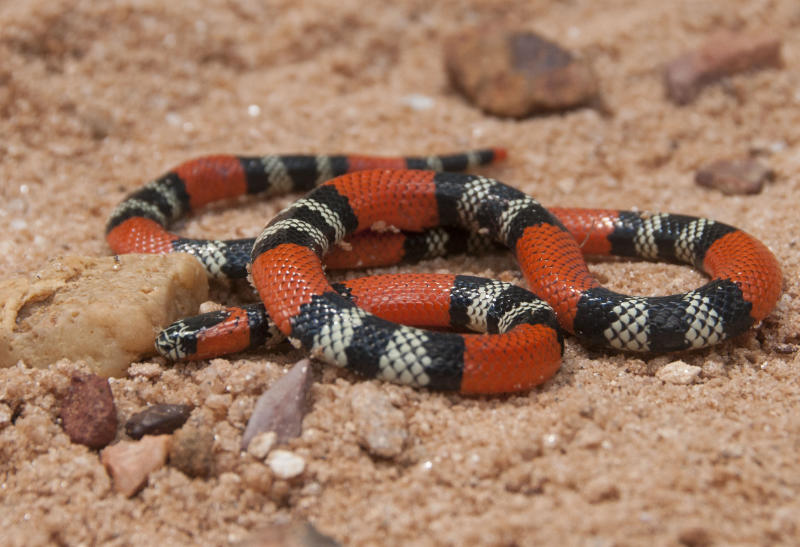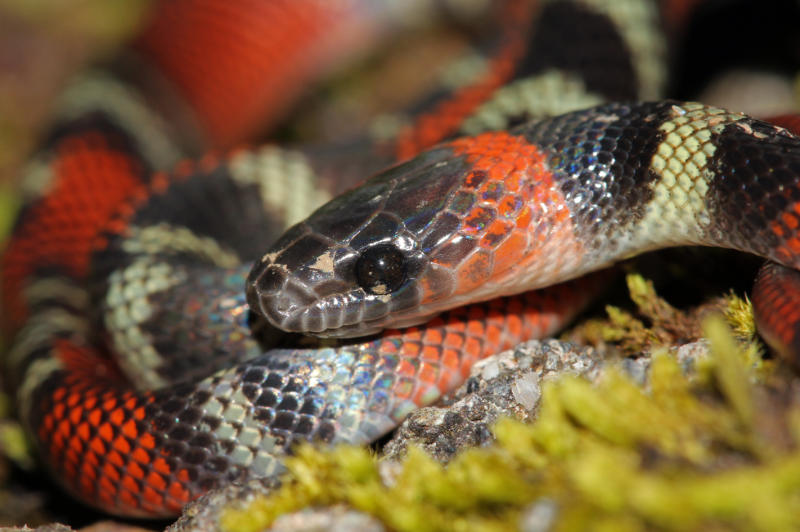Coral Snake
Coral Snake
Coral snakes are easily identifiable by their bright colours. They're very pretty - but the strong colours are there to send a message: Danger! Don't touch!!
Coral Snake
- Uruguayan coral snake - Micrurus altirostris
- Mesopotamian coral snake - Micrurus baliocoryphus
- Brazilian coral snake - Micrurus brasiliensis
- Diana's coral snake - Micrurus diana
- Cerrado coral snake - Micrurus frontalis
- Argentinean coral snake - Micrurus pyrrhocryptus
- Micrurus silvae
- Micrurus tricolor
Appearance

or

Aside from their bright colours as described above, coral snakes can be distinguished by their blunt rounded head and nose, small eyes, and the lack of any noticeable distinction between their head and neck. The head and tail appear similar, partly as a strategy to fool potential predators into attacking the wrong end - but the tail can be distinguished by its pointed end. Coral snakes are quite small - ranging from 50 cm to 1.2 m.
Venom and Bites
Scientific Name
Micrurus frontalis

Local Name
Coral verdadeira
(true coral snake)

Description
Several variations, reaching up to 1.2 m. Varying arrangements of red, black, and white bands. False coral snakes can be differentiated by the shape of the head.
This map shows the distribution snakes from the genus micrurus, or southern coral snakes. Micrurus frontalis is the species most likely to be present in the Pantanal - but is rare and unlikely to be encountered due to its shy and secretive nature.
Behaviour and Habitat
Unlike many other snakes, corals actively hunt for their food rather than hiding and waiting for their prey to pass by. They feed on amphibians and small reptiles, such as skinks, rodents, nestling birds, and even other smaller snakes. Prey animals are killed with a poisonous bite then swallowed whole, head first.
Reproduction
Southern coral snake (mIcrurus frontalis) photographed in the cerrado around Brasília. Photo: William Quatman.
True and False Coral Snakes
- A true coral snake has a blunt rounded nose, small eyes, and no visible distinction between head and neck.
- A false coral snake may have less distinct bands (just covering the back, and not wrapping around the underside), and a larger head relative to the size of it's body.
Some false coral snakes, such as Calico snake still use venom to kill their prey, but aren't sufficiently toxic to be dangerous. In some ways, their preferred habitat and prey also mirror those of the snake that they are mimicking. One mimic within the Pantanal region, the Mato Grosso Burrowing snake (Phalotris matogrossensis) was discovered as recently as 2005. This is a comparatively rare species, which has a red body, with a pattern of black and white bands covering only the head area.
Conservation and Threats
Quick Facts
- Coral snakes spend much of their time underground during the day, in holes or tunnels dug by other animals. They can be also found hidden under leaf litter, or in tree stumps.
- Hatchings have the same bold coloration as adults, and are fully venomous.
- Coral snakes are fixed-fanged, meaning they're unable to retract their fangs like rattlesnakes or lanceheads.
- Because of the rarity of their bites, stocks of coral snake anti-venom in the US had been left to expire. Pfizer, the manufacturer of the product called Coralmyn, claimed the $5-$10 million required to produce a newer synthetic anti-venom was simply uneconomic given the very small number of cases each year. Fortunately, many Latin American countries, including Brazil, manufacture their own supplies, and which are more appropriate for the local species.
Banner image: Micrurus frontalis (Fábio Maffei).


